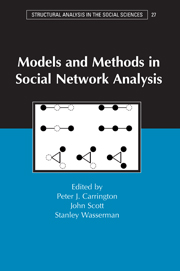Book contents
- Frontmatter
- Contents
- Acknowledgments
- Contributors
- 1 Introduction
- 2 Recent Developments in Network Measurement
- 3 Network Sampling and Model Fitting
- 4 Extending Centrality
- 5 Positional Analyses of Sociometric Data
- 6 Network Models and Methods for Studying the Diffusion of Innovations
- 7 Using Correspondence Analysis for Joint Displays of Affiliation Networks
- 8 An Introduction to Random Graphs, Dependence Graphs, and p*
- 9 Random Graph Models for Social Networks: Multiple Relations or Multiple Raters
- 10 Interdependencies and Social Processes: Dependence Graphs and Generalized Dependence Structures
- 11 Models for Longitudinal Network Data
- 12 Graphic Techniques for Exploring Social Network Data
- 13 Software for Social Network Analysis
- Index
- Structural Analysis in the Social Sciences
2 - Recent Developments in Network Measurement
Published online by Cambridge University Press: 05 June 2012
- Frontmatter
- Contents
- Acknowledgments
- Contributors
- 1 Introduction
- 2 Recent Developments in Network Measurement
- 3 Network Sampling and Model Fitting
- 4 Extending Centrality
- 5 Positional Analyses of Sociometric Data
- 6 Network Models and Methods for Studying the Diffusion of Innovations
- 7 Using Correspondence Analysis for Joint Displays of Affiliation Networks
- 8 An Introduction to Random Graphs, Dependence Graphs, and p*
- 9 Random Graph Models for Social Networks: Multiple Relations or Multiple Raters
- 10 Interdependencies and Social Processes: Dependence Graphs and Generalized Dependence Structures
- 11 Models for Longitudinal Network Data
- 12 Graphic Techniques for Exploring Social Network Data
- 13 Software for Social Network Analysis
- Index
- Structural Analysis in the Social Sciences
Summary
This chapter considers study design and data collection methods for social network studies, emphasizing methodological research and applications that have appeared since an earlier review (Marsden 1990). It concentrates on methods and instruments for measuring social relationships linking actors or objects. Many analytical techniques discussed in other chapters identify patterns and regularities that measure structural properties of networks (such as centralization or global density), and/or relational properties of particular objects/actors within them (such as centrality or local density). The focus here is on acquiring the elementary data elements themselves.
Beginning with common designs for studying social networks, the chapter then covers methods for setting network boundaries. A discussion of data collection techniques follows. Survey and questionnaire methods receive primary attention: they are widely used, and much methodological research has focused on them. More recent work emphasizes methods for measuring egocentric networks and variations in network perceptions; questions of informant accuracy or competence in reporting on networks remain highly salient. The chapter closes with a brief discussion of network data from informants, archives, and observations, and issues in obtaining them.
Network Study Designs
The broad majority of social network studies use either “whole-network” or “egocentric” designs. Whole-network studies examine sets of interrelated objects or actors that are regarded for analytical purposes as bounded social collectives, although in practice network boundaries are often permeable and/or ambiguous.
Information
- Type
- Chapter
- Information
- Models and Methods in Social Network Analysis , pp. 8 - 30Publisher: Cambridge University PressPrint publication year: 2005
Accessibility standard: Unknown
Why this information is here
This section outlines the accessibility features of this content - including support for screen readers, full keyboard navigation and high-contrast display options. This may not be relevant for you.Accessibility Information
- 261
- Cited by
